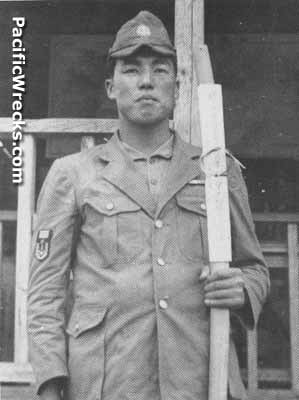251 Kōkūtai (251 Air Group)
Imperial Japanese Navy (IJN)
Background
On November 1, 1942 the Imperial Japanese Navy (IJN) redesignated Kōkūtai (Air Group) with three digit identifiers. The Tainan Kōkūtai (Tainan Air Group) was redesignated as the 251 Kokutai (251 Air Group).
Gekko / Irving reconnaissance
In early June 1942, the 251 Kokutai received their first three Type 2 Land Based Reconnaissance Aircraft / J1N1 Irving reconnaissance aircraft from the 3rd Kōkūtai (3rd Air Group). These aircraft were assigned tail codes V-1, V-2 and V-3 and became a reconnaissance unit.
Night Fighter operations over Rabaul
On May 10, 1943 the 251 departs Japan and returns to Rabaul.
During May 1943 the 251 Kokutai received two J1N1 Gekko at Lakunai Airfield at Rabaul in accordance with a suggestion from Commander Yasuna Kozono both were field modified as night fighters armed with upward and downward firing 20mm cannons. These two field modified night fighters were flown by pilots Shigetoshi Kudo and Satoru Ono.
Richard Dunn adds:
In May 1943 when 251 Kokutai (ex Tainan) returned to Rabaul only one of its Type 2 land recon planes (J1N1 Irving) was configured as a fighter. The others were still in recce configuration and the name 'Gekko' had not yet been adopted for the fighter version. So the only designation either version was known by was Type 2 land recce. A document recovered at Lae contains a list of a/c arriving there in May 43. The entry for 18 May 43 includes: 'Navy Air 251 Air...Type 2 Army Recce...1 plane' "Army" is no doubt a mistranslation of "land." So at least one Type 2 land recce arrived at Lae. Whether it was a recce version or a fighter version is unclear though I suspect it is unlikely the sole fighter would have been sent to a dangerous forward airfield that was under Army jurisdiction. More likely it was a recce flying to some distant target."
On May 21, 1943 J1N1 Irving piloted by Shigetoshi Kudo was the first to test the aircraft in combat and
score confirmed victories. Over Rabaul, he shot down B-17E "Honi Kuu Okole" 41-9244 and B-17E 41-9011 firing only 178 rounds of ammunition.
On June 26, 1943 Kudo shot down B-17E "Naughty But Nice" 41-2430 and B-17F "Taxpayers Pride" 41-24448.
On June 30, 1943 Kudo shot down B-17F "Pluto" 41-24543 using his oblique 20mm cannons and observed this bomber crash into the mountains southeast of Cape Lambert. This was Kudo's last night fighter victory over Rabaul.
Night Fighter operations from Ballale
During late June 1943 until July 1943 several J1N1 Irvings from 251 Kokutai were based at Ballale Airfield.
On July 7, 1943 pilot Shigetoshi Kudo shot down Hudson NZ2033 from above using his downward firing 20mm cannons.
On July 17, 1943 J1N1 Irving piloted by Satoru Ono shot down PB4Y Liberator 31952.
 After returning to Rabaul, Shigetoshi Kudo was presented a ceremonial sword by Admiral Jinichi Kusaka for his night fighter service and was officially credited with nine victories and nicknamed "King of the Night". After returning to Rabaul, Shigetoshi Kudo was presented a ceremonial sword by Admiral Jinichi Kusaka for his night fighter service and was officially credited with nine victories and nicknamed "King of the Night".
On September 1, 1943 reorganization
solely a night fighter unit with twenty four J1N1 Gekko night fighters.
During February 1944 the remaining ten J1N1 Gekkos were withdrawn from Rabaul to Truk. In late March 1944 and April 1944 operated from Eten Airfield (Takeshima). Between April 16-17, 1944 the Gekkos operated from Param Airfield.
During March 1944 Imperial Japanese Navy Kokutai (Air Group) were reorganized into Sento Hikotai (Flying Unit) letter and three digits: S-XXX for fighter, K-XXX for attack (bomber) or T-XXX for reconnaissance. The 251 Kokutai night fighters were designated S-901
as fighters.
On July 10, 1944 moves to western New Guinea and assigned to 153 Kōkūtai (153 Ku) with one J1N1 Gekko left at Eten Airfield. Afterwards, 251 Kōkūtai disbanded.
251 Kokutai Tail Code and Markings
251 Kokutai A6M2 / A6M3 Zeros tail code "V-1??" (three digits in 100's range).
251 Kokutai / 251 Kokutai J1N2 Gekko/Irvings had tail code "V-? (one digit).
251 Kokutai Aircraft
Listing of aircraft assigned to the 251 Kokutai.
251 Kokutai Personnel (Partial List)
Shigetoshi Kudo pilot J1N1 Gekko
Satoru Ono pilot J1N1 Gekko
Akira Sugawara observer J1N1 Gekko
References
Kodochosho, 251 Kōkūtai, May 21, 1943
Kodochosho, 251 Kōkūtai, June 13, 1943
Kodochosho, 251 Kōkūtai, June 26, 1943
Kodochosho, 251 Kōkūtai, June 30, 1943
Kodochosho, 251 Kōkūtai, July 7, 1943
Kodochosho, 251 Kōkūtai, July 17, 1943
Moonlight Interceptor (1985) details the Tainan Kokutai J1N1 Gekko / Irving operations including pilots Shigetoshi Kudo and Satoru Ono.
Naval Night Fighters by Yoji Watanabe 28-45
Japanese Naval Air Force Fighter Units and Their Aces, 1932-1945 (2011)
The Siege of Rabaul (1996) by Henry Sakaida page 38-41
Imperial Japanese Navy Aces 1937-45 (1998) by Henry Sakaida pages 49-50
Ken’s Men Against The Empire Volume 1 (2015) pages 189-192 (May 21, 1943 Kudo double victories), 196 (251 Kokutai returns Rabaul May 10, 1943), 203-204 (June 13, 1943 Kudo victory),
211, 213 (painting caption), 214 (painting), 232-235 (June 26, 1943 Kudo double victories), 238 (J1N1 Lakunai), 316-317 (May 21, 1943 B-17 crews) 318 (June 13, 1943 B-17 crew), 318-319 (June 26, 1943 B-17 crews), 319 (June 30, 1943 B-17 crew), 351-352 (profile 3 description), 359-360 (profile 11 B-17E 41-2430 description), 396 (index Kudo)
Thanks to Henry Sakaida, Osamu Tagaya, Richard Dunn and Edward Rogers for additional information
Contribute Information
Do you have photos or additional information to add?
|